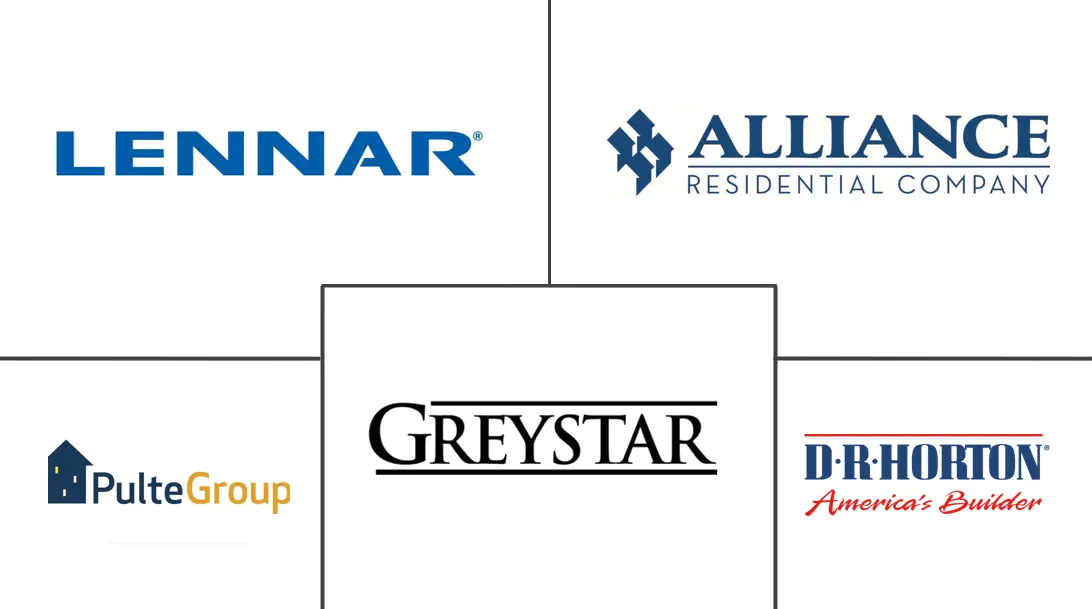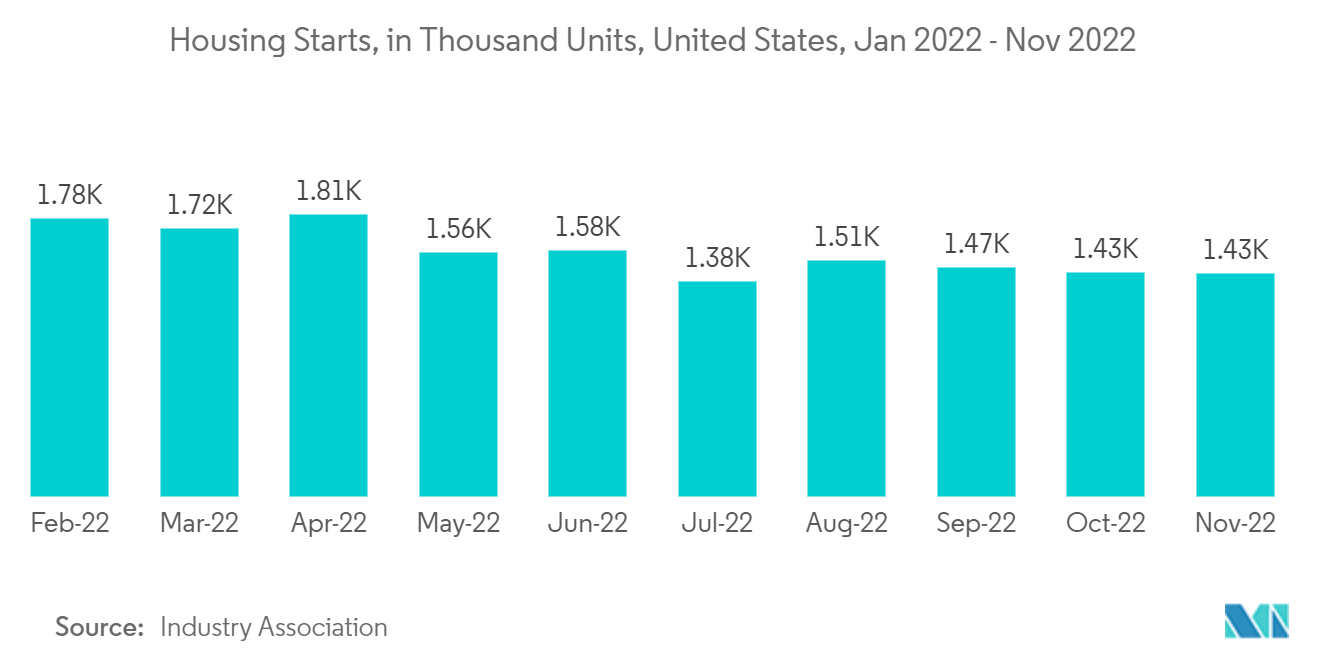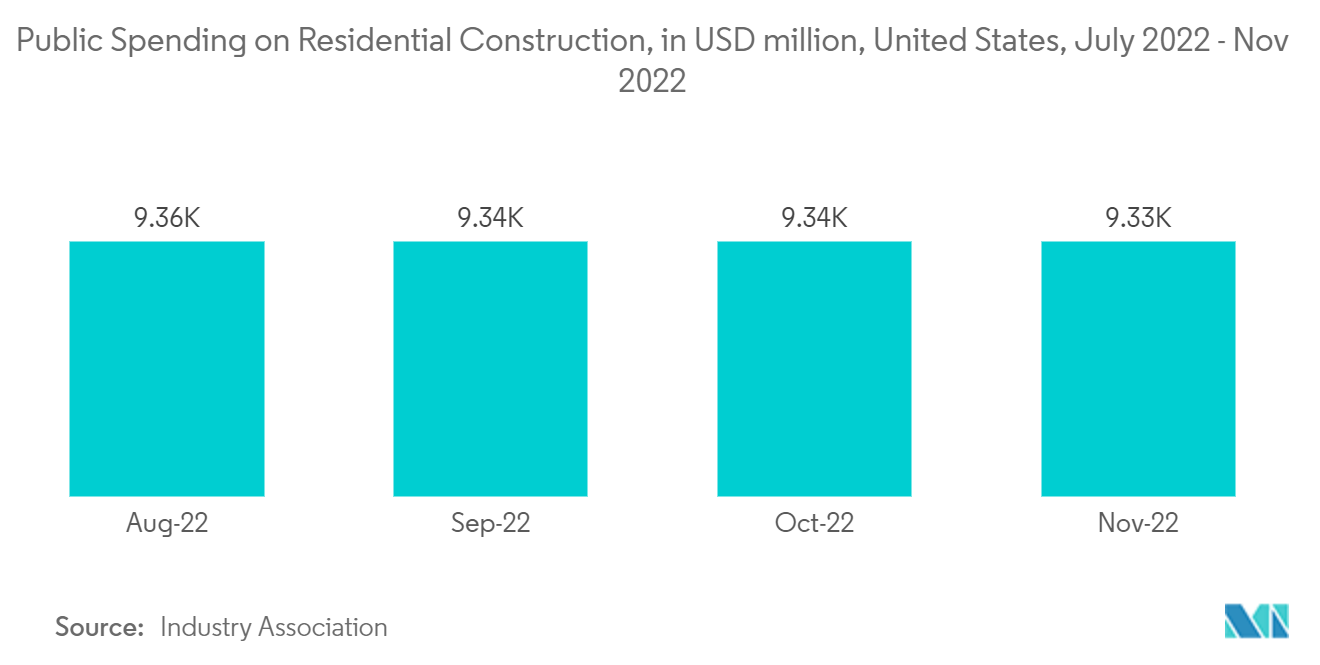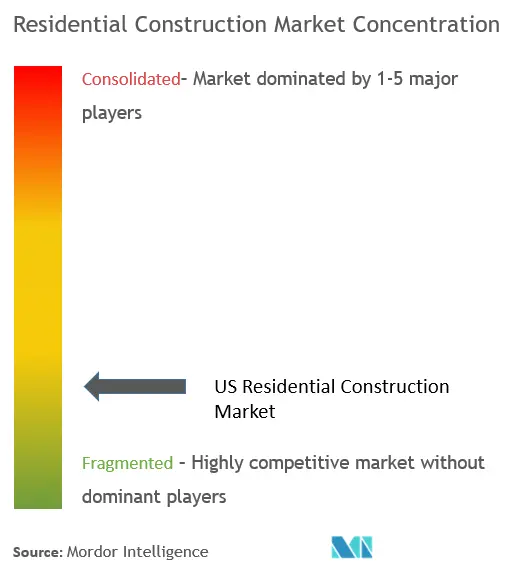US Residential Construction Market Analysis
The US Residential Construction Market is expected to register a CAGR of greater than 3% during the forecast period.
- In 2020, the federal funds rate target was lowered to near zero in response to fears of an economic slowdown from the spread of COVID-19 (coronavirus). Afterward, mortgage rates reached record lows. This, coupled with a low housing supply, fueled residential construction in early 2020. However, the fallout stemming from the coronavirus pandemic was worse than expected, leading to the temporary curtailment or complete shutdown of large bands of the economy. This weighed on residential investment in Q2-2020.
- While other economic indicators embarked on a quick but incomplete rebound, the residential market rebounded exceptionally rapidly, with the value of residential construction investment surpassing pre-pandemic levels before the end of the year 2020. Residential investment was being driven by a low housing stock and historically low mortgage rates. Growth in 2021 accelerated as the release of pent-up demand, alongside increased vaccinations among the population, led to increased residential construction activity. Labor market improvement has also helped support residential demand. Nonetheless, rising inflation in 2022 has pushed the Federal Reserve to raise interest rates to curtail spending amid recessionary fears. As a result, residential investments have slowed considerably with declines expected in 2022 and 2023.
- A divide between construction sectors in the United States has become visible as residential contractors brace for recession - but commercial and industrial buildings continue to boom. Rising interest rates have already driven the single-family homebuilding market into recession, but brisk non-residential activity continues. As recent trends indicate, costs of materials, fulfillment, labor, and land have surged. This had a direct impact on the residential construction industry. Additionally, the negative outlook in the housing market may be creating an even greater perception of discrepancy between the two areas of construction, with higher mortgage rates weighing heavily on demand - or lack thereof - for new housing. Newly released 'Construction Spending' data shows the industry continues to struggle in the current economic environment.
- The data for September 2022 shows that, in seasonally adjusted nominal terms, the industry grew 0.2% from August 2022 and 10.9% compared to the previous year. Overall construction spending growth has remained stable over 2022, mostly maintaining double-digit growth throughout the year. However, as this data is in nominal terms, the expansion mainly reflects the jump in prices across the industry. The balance between residential and non-residential sector growth has also been shifting. The residential sector has shown persistent deceleration in month-on-month (MoM) growth towards the end of 2022, and year-on-year (YoY) growth has followed a downward trend from May 2021. Meanwhile, non-residential construction growth has accelerated, in February 2022, YoY growth turned positive and stood at 9.2% as of September 2022.
US Residential Construction Market Trends
High-interest Rates are Negatively Impacting the Market
The United States homebuilders were a major beneficiary of the Covid economy. Record low-interest rates, combined with surging demand from consumers looking for more living space, caused a run on housing unlike most had ever seen before. Home prices surged over 40% in just two years, and homebuilders couldn't meet the orders fast enough. They even slowed sales just to keep pace. However, this growth declined at the end of 2022. Housing starts for single-family homes dropped nearly 19% year over year in September 2022, according to the U.S. Census. Building permits, which are an indicator of future construction, fell 17%. PulteGroup, one of the nation's largest homebuilders, reported its cancelation rate jumped from 15% in the second quarter of this year to 24% in the third. In Q2 2022, single-family housing starts were still up 10% year over year. That was just before mortgage rates really started to jump quickly. To go from a 10% annual gain in construction to a 19% drop in that time frame is a historically sharp turn. While sales of newly built homes are falling, prices are still higher compared with a year ago. Much of that has to do with still-inflated prices for labor and materials. Part of the price strength may just be indicative of which homes are selling, namely the more expensive ones. But that may change soon, as well.
Sales of newly built homes dropped below pre-pandemic levels in September 2022, and cancelations are now double what they were a year ago, according to the National Association of Home Builders. Construction on new United States homes fell a seasonally adjusted 0.5% in November to 1.43 million. The drop in construction on homes follows the decline in October 2022 when housing starts also fell by 2.1%. The annual rate of total housing starts fell from 16.4% in 2021. Building permits for new homes fell 11.2% to 1.34 million in November 2022. Permits for single-family homes fell 7.1% in November 2022, while permits in buildings with at least five units plunged by 17.9%. A big reason for this is mortgage rates that are still elevated, keeping buyer demand low and builders gloomy. Rates have surpassed the 7% mark and builders have been offering incentives to lure buyers, but home buyers are barely returning to the market. Homebuilders say 2023 is going to bring an even sharper downturn in the market, as high-interest rates scare away buyers.
Affordable Housing Support to Drive the Market Growth
The President of the United States signed into law of USD 1.7 trillion yearlong federal government spending package in December 2022, after the House and Senate passed it. The final spending bill provides funding increases to many programs compared to FY22, including significant funding for NLIHC's top priorities. Enough funding is provided to renew all existing contracts provided through Housing Choice Vouchers (USD 30.3 billion) and Project-Based Rental Assistance (USD 14.9 billion), and the bill expands rental assistance vouchers to an additional 12,000 households targeted to individuals and families experiencing or at risk of homelessness. Other programs also received an increase in funding, including Homeless Assistance Grants (USD 3.6 billion), Public Housing Operating Funds (USD 5.1 billion), Native American housing block grants (USD 787 million), Housing for Persons with AIDS (USD 499 million), Section 202 Housing for the Elderly (USD 1.08 billion), Section 811 Housing for People with Disabilities (USD 360 million), and fair housing programs (USD 86 million).
Overall, the final spending bill provides HUD programs with USD 61.8 billion, or USD 8.1 billion more than FY22-enacted levels. The legislation provides USD 3.6 billion for homeless assistance grants, a 13% increase. It will serve more than 1 million people experiencing homelessness. The package also funnels nearly USD 6.4 billion to the Community Development Block Grant formula program and related local economic and community development projects that benefit low- and moderate-income areas and people, an increase of almost USD 1.6 billion. Plus, it provides USD 1.5 billion for the HOME Investment Partnerships Program, which will lead to the construction of nearly 10,000 new rental and homebuyer units and maintain the record investment from the last fiscal year. Thus, by helping provide affordable housing, the legislation will drive growth in the residential construction sector in the United States.
US Residential Construction Industry Overview
The United States residential construction Market is fragmented and highly competitive, with the presence of major local and international players. However, opportunities are opening up for small and medium players due to increasing govt investments in the sector. Major players in the market include D.R. Horton, Lennar Corp., PulteGroup, Greystar Worldwide, and Alliance Residential. The market presents opportunities for growth during the forecast period, which is expected to drive market competition further. Major players are competing among themselves for an increase in market share which leaves the industry with no observable levels of consolidation.
US Residential Construction Market Leaders
-
D.R. Horton
-
Lennar Corp.
-
PulteGroup
-
Greystar Worldwide
-
Alliance Residential
- *Disclaimer: Major Players sorted in no particular order
US Residential Construction Market News
- June 2022 - Pulte Homes - a national brand of PulteGroup, Inc. - announced the opening of its newest Boston-area community, Woodland Hill. Offering 46 new construction single-family homes in the charming town of Grafton, the community is conveniently located near schools, dining, and entertainment, with the Massachusetts Bay Transportation Authority commuter rail less than a mile away. The collection of home designs at Woodland Hill includes three two-story floor plans, ranging in size from 3,013 to 4,019 sq. ft. with four to six bedrooms, 2.5-3.5 baths, and 2-3 car garages. These spacious home designs feature flexible living spaces, plenty of natural light, gas fireplaces, and the signature Pulte Planning Center®, a unique multi-use workstation perfect for homework or a family office.
- December 2022 - D.R. Horton, Inc. announced the acquisition of Riggins Custom Homes, one of the largest builders in Northwest Arkansas. The homebuilding assets of Riggins Custom Homes and related entities (Riggins) acquired include approximately 3,000 lots, 170 homes in inventory, and 173 homes in the sales order backlog. For the trailing twelve months ended November 30, 2022, Riggins closed 153 homes (USD 48 million in revenue) with an average home size of approximately 1,925 square feet and an average sales price of USD 313,600. D.R. Horton expects to pay approximately USD 107 million in cash for the purchase, and the Company plans to combine the Riggins operations with the current D.R. Horton platform in Northwest Arkansas.
US Residential Construction Industry Segmentation
Residential construction is a process that involves the expansion, renovation, or construction of a new home or spaces intended to be occupied for residential purposes. These spaces can be anything from rental spaces, condominiums, and luxury mansions, to single-family housing projects. The United States residential construction market is segmented by Type (Single Family, and Multi-Family), by Construction Type (New Construction and Renovation), and by City (New York City, Los Angeles, San Francisco, Washington DC, Miami, and Other Cities). The report offers market sizes and forecasts for the United States residential construction market (in USD Billion) for all the above segments.
| By Type | Apartment & Condominiums |
| Villas | |
| Other types | |
| By Construction Type | New Construction |
| Renovation | |
| By City | New York City |
| Los Angeles | |
| San Francisco | |
| Washington DC | |
| Miami | |
| Other Cities |
US Residential Construction Market Research FAQs
What is the current US Residential Construction Market size?
The US Residential Construction Market is projected to register a CAGR of greater than 3% during the forecast period (2025-2030)
Who are the key players in US Residential Construction Market?
D.R. Horton, Lennar Corp., PulteGroup, Greystar Worldwide and Alliance Residential are the major companies operating in the US Residential Construction Market.
What years does this US Residential Construction Market cover?
The report covers the US Residential Construction Market historical market size for years: 2020, 2021, 2022, 2023 and 2024. The report also forecasts the US Residential Construction Market size for years: 2025, 2026, 2027, 2028, 2029 and 2030.
Our Best Selling Reports
US Residential Construction Industry Report
The market size of the US residential construction market is poised for steady growth, driven by increasing household formation rates, favorable government policies, and a rising focus on sustainability. The industry overview highlights key market segments such as single-family homes and multi-family dwellings, including apartments and condominiums, which are significant contributors to the industry's expansion. Market analysis shows that the demand for new construction and renovation projects continues to rise, fueled by urbanization and the growing need for affordable housing solutions.
Industry analysis reveals that challenges such as labor shortages and rising material costs pose hurdles, yet the market remains robust due to strong economic indicators and consumer demand for energy-efficient and eco-friendly homes. Industry statistics indicate that opportunities in sustainable construction and affordable housing initiatives are set to shape the future of the sector, offering the potential for innovation and growth in market size and practices.
The market forecast outlook and historical overview are provided in terms of USD Billion for all the segments. Market growth is driven by strong economic indicators and consumer demand for energy-efficient homes. The market leaders are focusing on sustainable construction and affordable housing initiatives. The market report from Mordor Intelligence™ Industry Reports includes detailed industry research and statistics.
Industry reports provide a comprehensive understanding of the sector's dynamics, including market data, market segmentation, market value, and market review. The industry outlook suggests continued growth with opportunities for innovation. Market predictions and market trends highlight the importance of sustainable practices. Market overview and market outlook are essential for understanding future directions.
Report example and report pdf downloads are available for detailed insights. Research companies are actively analyzing the market to provide accurate industry information. Industry sales and industry size are expected to increase, driven by favorable market conditions. Industry research and industry trends emphasize the growing importance of eco-friendly homes. Market leaders are setting the pace for future developments in the US residential construction market.







